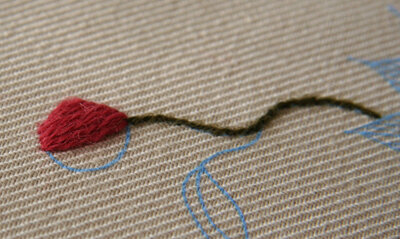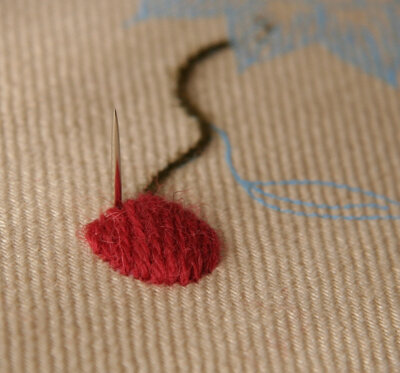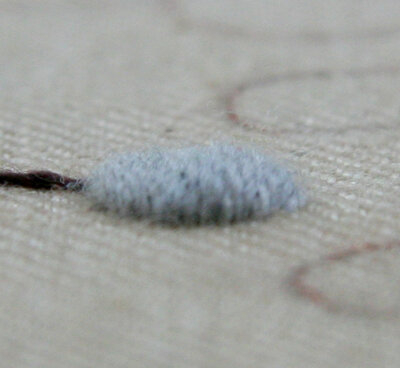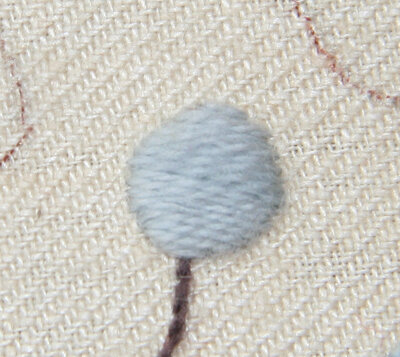Padded satin stitch two ways
Crewel work is all I'm doing right now and I'm loving it. The weather is getting cooler so the texture of the yarn is perfect and, since both designs are so gorgeous, it's a pleasure to make every stitch. Coincidentally this weekend, both projects were at a point where I was doing padded satin stitch and the methods used were different. The Marriage Pillowe began with working a stem in stem stitch and a berry in padded satin stitch. To work the berry, the instructions are to use double thread, stitching from the center of the shape to one edge and then go back to the center and work to the opposite edge. No split stitch to outline the shape is called for. I will admit, this caused me to stop, re-read the instructions, have a little debate with myself about if I should do it the way I usually do or follow the instructions. Since I'm doing this as a test stitcher, I felt bound to follow the instructions. Good choice.After filling the shape with satin stitch, the next step was to repeat the same sequence to cover the berry with a second layer of satin stitches using the same stitching holes to cover exactly the same area, working them in the same direction.
The Marriage Pillowe began with working a stem in stem stitch and a berry in padded satin stitch. To work the berry, the instructions are to use double thread, stitching from the center of the shape to one edge and then go back to the center and work to the opposite edge. No split stitch to outline the shape is called for. I will admit, this caused me to stop, re-read the instructions, have a little debate with myself about if I should do it the way I usually do or follow the instructions. Since I'm doing this as a test stitcher, I felt bound to follow the instructions. Good choice.After filling the shape with satin stitch, the next step was to repeat the same sequence to cover the berry with a second layer of satin stitches using the same stitching holes to cover exactly the same area, working them in the same direction. One of the things I like about the new instructions from The Crewel Work Company are the tidbits of historical information included. "The raised effect this creates is typical of Jacobean needlework, a period when raised embroidery was very much in fashion". As you can see from the photo above, the berry is very raised off the fabric. It looks fat and luscious. I don't notice the lack of the split stitch edging.The Marriage Pillowe is a kit that reproduces both a historical design and historical stitches. The instructions are very, very specific and clear. This slight variation in how I worked padded satin stitch took me out of my usual way of doing things and right back in time, thinking to myself, "So this is how someone a long, long time ago did this. It works and looks lovely".
One of the things I like about the new instructions from The Crewel Work Company are the tidbits of historical information included. "The raised effect this creates is typical of Jacobean needlework, a period when raised embroidery was very much in fashion". As you can see from the photo above, the berry is very raised off the fabric. It looks fat and luscious. I don't notice the lack of the split stitch edging.The Marriage Pillowe is a kit that reproduces both a historical design and historical stitches. The instructions are very, very specific and clear. This slight variation in how I worked padded satin stitch took me out of my usual way of doing things and right back in time, thinking to myself, "So this is how someone a long, long time ago did this. It works and looks lovely". The next section of the Royal Persian Blossom project was a long, thin stem with blue berries worked in padded satin stitch, French knots and buttonhole wheels. For these padded satin stitch berries, I did outline each with split stitch, then stitched the first layer vertically, or in line with the stem, and the second layer horizontally to the stem.
The next section of the Royal Persian Blossom project was a long, thin stem with blue berries worked in padded satin stitch, French knots and buttonhole wheels. For these padded satin stitch berries, I did outline each with split stitch, then stitched the first layer vertically, or in line with the stem, and the second layer horizontally to the stem. The instructions for the Royal Persian Blossom state "satin stitch the area just inside the border in the opposite direction of the desired finished satin stitches. Then, satin stitch carefully on top of the padding stitches, covering the border outline".In neither set of instructions does it say to work split stitch around the outside of the shape first. However, I did it anyway in the Royal Persian Blossom berries because I remember learning it makes for a better edge.The Royal Persian Blossom design is just that, a design. Stitching instructions are provided, but they are less specific and it is assumed that you have at least a basic knowledge of crewelwork.Of course, there is always the variable of the embroiderer. In one case I am going to follow the instructions exactly because it's my responsibility to do so. In the other, I can freely make choices. And I did.I'll let you in on a secret: one of the berries was meant to be French knots and I did buttonhole by mistake. Therefore, I changed the stitch in a few other berries so the three different stitches would be better distributed along the stem. Why? I had cookies in the oven at the same time I was stitching! My multitasking isn't what it used to be. Oh, but they are such good cookies...wish I could share them with you!
The instructions for the Royal Persian Blossom state "satin stitch the area just inside the border in the opposite direction of the desired finished satin stitches. Then, satin stitch carefully on top of the padding stitches, covering the border outline".In neither set of instructions does it say to work split stitch around the outside of the shape first. However, I did it anyway in the Royal Persian Blossom berries because I remember learning it makes for a better edge.The Royal Persian Blossom design is just that, a design. Stitching instructions are provided, but they are less specific and it is assumed that you have at least a basic knowledge of crewelwork.Of course, there is always the variable of the embroiderer. In one case I am going to follow the instructions exactly because it's my responsibility to do so. In the other, I can freely make choices. And I did.I'll let you in on a secret: one of the berries was meant to be French knots and I did buttonhole by mistake. Therefore, I changed the stitch in a few other berries so the three different stitches would be better distributed along the stem. Why? I had cookies in the oven at the same time I was stitching! My multitasking isn't what it used to be. Oh, but they are such good cookies...wish I could share them with you!
